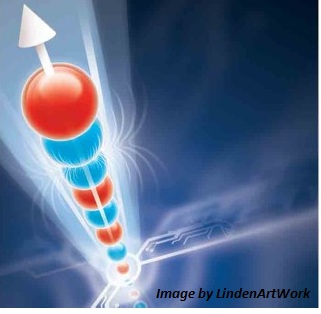Yo-yo 3D microchip could transform storage capacity

The silicon chip incorporates cobalt, platinum and ruthenium
Scientists from the University of Cambridge have created a new type of microchip which allows information to travel in three dimensions.
The researchers say that currently, microchips can only pass digital information in a very limited way, from either left to right or front to back.
Reinoud Lavrijsen from the University of Cambridge, says, "Today's chips are like bungalows, everything happens on the same floor. We've created the stairways allowing information to pass between floors."
Researchers believe that in the future a 3D microchip would enable additional storage capacity on chips by allowing information to be spread across several layers instead of being compacted into one layer, as is currently the case.
The Cambridge scientists used a special type of microchip called a spintronic chip which exploits the electron's tiny magnetic moment or "˜spin' (unlike the majority of today's chips which use charge-based electronic technology).
Spintronic chips are increasingly being used in computers, and it is widely believed that within the next few years they will become the standard memory chip.
To create the microchip, the researchers used an experimental technique called "˜sputtering'. They effectively made a club-sandwich on a silicon chip of cobalt, platinum and ruthenium atoms.
The cobalt and platinum atoms store the digital information in a similar way to how a hard disk drive stores data. The ruthenium atoms act as messengers, communicating that information between neighbouring layers of cobalt and platinum. Each of the layers are only a few atoms thick.
They then used a laser technique called MOKE to probe the data content of the different layers. As they switched a magnetic field on and off they saw in the MOKE signal the data climbing layer by layer from the bottom of the chip to the top. They then confirmed the results using a different measurement method.
Russell Cowburn, lead researcher of the study from the Cavendish Laboratory, the University of Cambridge's Department of Physics, says, "Each step on our spintronic staircase is only a few atoms high. I find it amazing that by using nanotechnology not only can we build structures with such precision in the lab but also using advanced laser instruments we can actually see the data climbing this nano-staircase step by step."
"This is a great example of the power of advanced materials science. Traditionally, we would use a series of electronic transistors to move data like this. We've been able to achieve the same effect just by combining different basic elements such as cobalt, platinum and ruthenium. This is the 21st century way of building things - harnessing the basic power of elements and materials to give built-in functionality."
Details of this work were accessed from the site : http://www.cam.ac.uk/research/news/3d-microchip-created/
The research was funded by the European Research Council, the Isaac Newton Trust, and the Netherlands Organisation for Scientific Research (NWO).
































